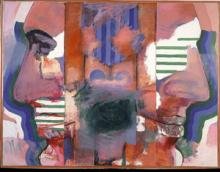Luis Gordillo
dal 18/6/2007 al 14/10/2007
Segnalato da
18/6/2007
Luis Gordillo
Museo Nacional Centro de Arte Reina Sofia, Madrid
Iceberg Tropical. Anthological Exhibition 1959-2007

Iceberg Tropical. Anthological Exhibition 1959-2007
Luis Gordillo (Seville, 1934), awarded the 2007 Velázquez Prize –Spain’s maximum recognition of a whole career in plastic art- has been one of the most influential figures in Spanish art for the last forty years. It was in the mid-fifties when, after obtaining a law degree and studying music, Gordillo decided he wanted to be a painter and attended the Seville Fine Arts School for two years. In summer 1958 he was in Paris soaking up culture -reading, visiting museums and going to the cinema- but above all living in a climate of freedom then difficult to do in Spain. He also widened his knowledge of the contemporary avant-garde especially Informalism and geometrical art. When he returned to Paris in 1959 -this time for two years- he painted mainly black tones on white, keeping to informalist parameters and following the breakaway trend begun by Michaux, Tàpies, Millares, Wols, etc.
On leaving Paris, his aesthetic standpoint and even his vocation as an artist went through a crisis. For the first time he became aware of painting’s critical situation -an awareness that has remained with him all his life but which has nevertheless become one of his basic resources. When he began to paint again in 1963 he turned to Pop aesthetics to create the famous Cabezas (1963-66) series and became a pioneer of this movement in Spain. A new influence, this time geometrical -evident in Peatones, Motoristas, etc.- concludes this period of “influences” that Gordillo views as his initial synthesis (Informalism, Pop, geometry) and which would give way to an unmistakably personal style. In 1966 he took part in the first exhibition of the Nueva Generación group organized by Juan Antonio Aguirre in which the possibility of opening a door to Spanish Informalism via a synthetic geometrical language was explored.
In 1970, after a lengthy crisis (Gordillo says that "crisism" is a good definition for his output) during which he did automatic drawings only, he began to paint pictures full of colour like La Pecera, Bañista Plein Soleil, etc, and with a new element: irony. The critics related these works to an emergent group called Nueva Figuración Madrileña formed by a younger generation of painters, some of whom Gordillo clearly influenced -Carlos Alcolea, Chema Cobo, etc. In the seventies, besides painting, he carried out experimental research into various methods of reproducing and altering images, whether his own (1ª Serie Lábil), completely photographic (Secuencias Edipianas), or from the media, changing them in a colour laboratory or by means of offset, photocopies etc. (Serie de Peter Sellers). The result of this investigation was the appearance in his painting of artificial, acid tones and monochrome.
In the eighties, Gordillo’s painting became more abstract and complex, less colourist and he even began to think about forming a connection with his initial Informalism. Series like Los Duetos, Serie Gruyère, Situaciones Meándricas appear and, at the close of the decade, very important works like Cilindración de Fluidos and Alternancia en Timbres. The concept of a “meandrous situation” has been fundamental to the development of his work since then. Basically it means finding a route for an almost linear, monochrome stroke that gradually extends the length and breadth of the picture, Gordillo’s idea of the diversity of automatism being essential to its forward movement. Another concept dealt with by the artist is the thermodynamic in painting -pictorial heat-gesture and cold-retention- which he relates ironically to Jackson Pollock’s works, significantly entitling a picture Blancanieves y el Pollock Feroz. For Gordillo, rather than focusing attention on specific works, the development of his painting requires an aerial view -like that of a river basin- in which a wide liquid, dynamic drawing can be seen. He gives priority to an idea of open process, develops progressive variations associated with his particular syntax using elements from his personal vocabulary and breaks the unity of the picture transforming it into a multiplicity.
Luis Gordillo has always been involved in the planning of his anthological exhibitions. On this occasion the project he has developed is very different from the one he prepared for his last major retrospective held at Museu d'Art Contemporani (MACBA), Barcelona, in 2000. Instead of a chronological exhibition of pieces selected according to their quality, this show has been conceived as a living space, a dynamic field of action and reaction between the works which shakes the observer. Loyal to the idea of facilitating the activation of pictures and space to the utmost and at the same time aware of the didactic implications of an anthological show, Gordillo attempts to reproduce the narrative tension that has characterized his whole career and proposes a very unusual heterodox exhibition by turning the exhibition itself into one more work of art.
Museo Nacional Centro de Arte Reina Sofía
Santa Isabel, 52 - Madrid
Mondays to Saturdays: 10.00 - 21.00; Sundays: 10.00 - 14.30; Close on Tuesday



